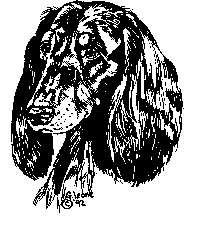
We've received a number of enquiries as to how to make your own dog food. The following is the recipe (or guidelines) we use, which, for us, works well.
Ours is a 3-part formula PLUS vitamin-minerals

We've received a number of enquiries as to how to make your own dog food. The
following is the recipe (or guidelines) we use, which, for us, works well.
Ours is a 3-part formula PLUS vitamin-minerals
Part 1 -- Use regular ground beef (or ground veal or poultry, but not pork), cook it and add either ground or diced tomatoes. Do not drain off the fat, as dogs metabolize fat the same way humans metabolize carbohyrates (in dogs it is converted to energy). The ground meat is your protein source and the tomato adds acid to prevent urinary tract problems;
Part 2 -- Cooked oatmeal (or brown rice) or a mixture thereof;
Part 3 -- Cooked veggies. We use peas and sometimes add carrots. Freshly cooked broccoli is OK, but avoid corn (passes right through) or beans of any sort (causes flatulance); you can also use frozen mixed veggies from your local supermarket.
Vitamin-Minerals -- It is essential that you use a combined vitamin-mineral supplement to ensure that your dog gets the required calcium, phosphorus, etc. We use Visorbits, but have in past used Theralin which is a product of Lambert-Kay. Any combined vitamin-mineral supplement is fine -- just make sure that you use the amount of supplement needed for the weight of your dog.
Calcium -- Because this meat diet is low in calcium, if you do not use a vitamin-mineral supplement, you can give one Tums tablet (calcium carbonate) daily.
We also give our dogs one 650mg Kelp tablet each day (to provide the trace minerals and vitamins which may be missing in their diet) and a teaspoon twice daily of cold pressed safflower oil (which contains the necessary linoleic and linolenic acids for their coats; these essential fatty acids, which are contained in raw meat, are converted to the less desirable trans-fatty acids by heat and so the addition of cold-pressed safflower oil makes up the deficiency).
A few months after "Sally" had her first litter, she developed a persistant e-coli bladder infection which was treated with antibiotics. We found that by adding either a couple of ounces of cranberry juice (not from concentrate) or a tablespoon of apple cider vinegar to each meal kept the infection from recurring. We have now added this to all our dogs meals. A benefit of apple cider vinegar is that it keeps the dogs' teeth clean.
Adjust the quantity you feed to fit the lifestyle and life cycle of your dog -- give more to puppies, pregnant or lactating bitches and dogs recovering from illness, and less to seniors.
An alternative recipe (which we fed for a few years quite successfully) substitutes raw meat in place of the cooked ground meat in Part I.
When raw meat is used, the advantages are:
At one time, we bought our meat for dogfood from local butchers who ground the tripe, lungs and trimmings from human grade (inspected and fit for human consumption) beef and then bagged it and froze it for us. When this was no longer available, we started to buy frozen lean ground beef, which we defrost as needed.
This is a modification of what is sometimes referred to as the BARF diet (Bones And Raw Food).
Copyright ©1997 through 2012 by Howard
Krakower
Last updated: November 20, 2012